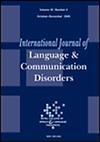Investigation of Rapid Naming and Language Skills in Children With Speech Sound Disorders
Abstract
Background
Rapid naming refers to the duration required to swiftly and accurately identify a set of familiar visual stimuli. Rapid naming serves as a significant indicator of the efficiency with which phonological information can be retrieved from memory, playing a crucial role in the advancement of language and literacy competencies.
Aim
This research aimed to thoroughly investigate the rapid naming and language skills of children with speech sound disorders (SSDs) and to explain the correlations between these competencies.
Methods and Procedures
Our study consisted of 50 children diagnosed with SSD. The participants were categorized into two groups: those with articulation disorders (n = 23) and those with phonological disorders (n = 27). The Turkish Test of Language Development-Primary (TOLD-P:4), the Articulation Subtest (AST) and the Auditory Discrimination Subtest (ADT) of the Turkish Articulation and Phonology Test (SST), the Stimulability Test, and the Rapid Naming Test (RNT) were used to test the children's language, articulation, and rapid-naming skills.
Outcomes and Results
In our study, children with articulation disorders exhibited significantly higher scores on picture vocabulary, relational vocabulary, and morphological completion scales from the TOLD-P:4 subtests compared to children with phonological disorders (t(48) = 2.504, p = 0.016; t(48) = 2.249, p = 0.029; t(48) = 2.744, p = 0.009). Simultaneously, it was determined that the average duration of children with articulation disorders in the object, color, and number tests, which are subtests of the RNT, exhibited significant differences when compared to children with phonological disorders (t(48) = −3.567, p = 0.001; t(48) = −2.888, p = 0.006; t(19) = −3.134, p = 0.005). A statistically significant negative correlation was observed between the mean duration of children with SSD in the object subtest of RNT and the scores on the stimulability and morpheme subtests (r = −0.387, p = 0.005; r = −0.326, p = 0.021). A notable negative correlation was found between the average duration of the color, letter, and number subtests of RNT and the ADT, as well as the percentage of stimulability (p < 0.05).
Conclusion and Implications
Children with phonological disorders exhibited differences in rapid naming and language skill compared to those with articulation disorders. At this point, professionals addressing SSD should assess the access speed to phonological information in the memory of preschool children with phonological difficulties, and phonological processing should be incorporated into speech production interventions.
WHAT THIS PAPER ADDS
- It is known that children diagnosed with speech sound disorders (SSDs) are at a markedly elevated risk of encountering language and reading difficulties during their school years.
- Retaining speech sounds in a child's language is also an integral part of phonological awareness. Rapid naming skills, which are an indicator of phonological processing skills, are very important. The fact that children with phonological disorders have a longer mean time in rapid naming skills indicates that these children have more difficulty accessing phonological representations from long-term memory. In addition, children with phonological disorders were found to have lower picture vocabulary, relational vocabulary, and morphological completion performances.
- Professionals should integrate phonological processing into speech production interventions to strengthen their knowledge of functional language performance and rapid naming skills of children with SSDs and to pave the way for later reading success.

 求助内容:
求助内容: 应助结果提醒方式:
应助结果提醒方式:


